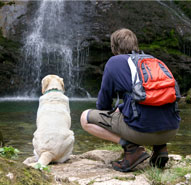Camping with Pets: Rabies
Share

 If you’re like me, the first thing that comes to mind when you hear ‘rabies” is the classic novel, Old Yeller. While your dog probably won’t run into any rabid wolves while camping, there are many other ways he can pick up the virus. So learn from the sad, cautionary tale and make sure your dogs are fully vaccinated before you embark on any camping adventure.
If you’re like me, the first thing that comes to mind when you hear ‘rabies” is the classic novel, Old Yeller. While your dog probably won’t run into any rabid wolves while camping, there are many other ways he can pick up the virus. So learn from the sad, cautionary tale and make sure your dogs are fully vaccinated before you embark on any camping adventure.
More than 90% of all animal cases reported annually to the CDC occur in the wilderness, and in the early 90s, woodchucks (yes, woodchucks), accounted for 86% of all reported rabies cases. The type of animal you are most likely to get rabies from will vary according to your location, so take the time to look the information up and educate yourself on the risk. We’ve done a lot of the work for you in this article, including a little about the disease, how to recognize an afflicted animal, and how to protect yourself and pets while camping.
About Rabies
The rabies virus is a very preventable viral disease of mammals that infects the nervous system and brain. It is transmitted through saliva when it penetrates skin tissue (i.e., a bite from an infected animal).
There are different strains of rabies. For example, there are three strains of rabies in Arizona alone. The most common animal to transmit these viruses are the big brown bat, grey fox, and skunks. Check your local Game and Fish department for information on the types of rabies viruses, the prevalence of rabies in your area, and most common animals to transmit the virus.
Transmission
Unless rabies is widespread in your area, small mammals such as squirrels, rats, mice, hamsters, guinea pigs, gerbils, chipmunks, rabbits, and hares are almost never found to be infected with rabies. Bites or scratches by these types of animals are not usually considered to be a risk.
Woodchucks and groundhogs (Marmota monax) are the only rodents that are known to cause a rabies infection. Bobcats and bats account for a large percentage of transmission in the Southwest.
Reducing Risk of Rabies Infection While Camping
 Be sure your pets are fully vaccinated in accordance with your state law. If you see an animal acting strangely or being unusually aggressive, report it immediately to your local law enforcement or forest ranger station. Remove yourself from the area and do not attempt to corner or interact with the animal. The same theory holds true for animals, such as bats, that are lying on the ground or appear to be dead. You should never allow your pets to interact with wildlife. By keeping your pets leashed in forest areas, you can help keep your own pets and wildlife safe and avoid the chance of running into an animal.
Be sure your pets are fully vaccinated in accordance with your state law. If you see an animal acting strangely or being unusually aggressive, report it immediately to your local law enforcement or forest ranger station. Remove yourself from the area and do not attempt to corner or interact with the animal. The same theory holds true for animals, such as bats, that are lying on the ground or appear to be dead. You should never allow your pets to interact with wildlife. By keeping your pets leashed in forest areas, you can help keep your own pets and wildlife safe and avoid the chance of running into an animal.
- Keep all pet food, and garbage secured and away from wildlife – such available food sources increase the numbers of animals around residential areas and reduce the wild animals’ natural instinct to avoid people.
- Wild animals are best appreciated from a distance. Don’t approach animals, especially those that appear sick. A bat on the ground is usually sick and should not be picked up.
- If you see a sick animal in a residential area or park, call the local animal control agency.
- Keep your pets away from wild animals and keep their rabies vaccinations current.
- When camping, do not sleep out in the open or on the ground.
- When hunting, wear latex or nitrile gloves to skin and dress your harvested animal.
Symptoms of Rabies in People and Pets
Symptoms often manifest within the first thirty days as a flu-like reaction, and include general weakness, aches and pains, fever, or headache. These symptoms may last for days. There may be also discomfort or a prickling or itching sensation at the site of bite, which can manifest within days to symptoms of cerebral dysfunction, anxiety, confusion, agitation. As the disease progresses, the person may experience delirium, abnormal behavior, hallucinations, and insomnia.
The acute period of disease typically ends after 2 to 10 days. Once clinical signs of rabies appear, the disease is nearly always fatal, and treatment can only include treating the symptoms and offering supportive care.
Treatment of Rabies in People and Pets
According to the CDC, “postexposure prophylaxis consists of a regimen of one dose of immune globulin and four doses of rabies vaccine over a 14-day period. Rabies immune globulin and the first dose of rabies vaccine should be given by your health care provider as soon as possible after exposure. Additional doses or rabies vaccine should be given on days 3, 7, and 14 after the first vaccination. Current vaccines are relatively painless and are given in your arm, like a flu or tetanus vaccine.”










